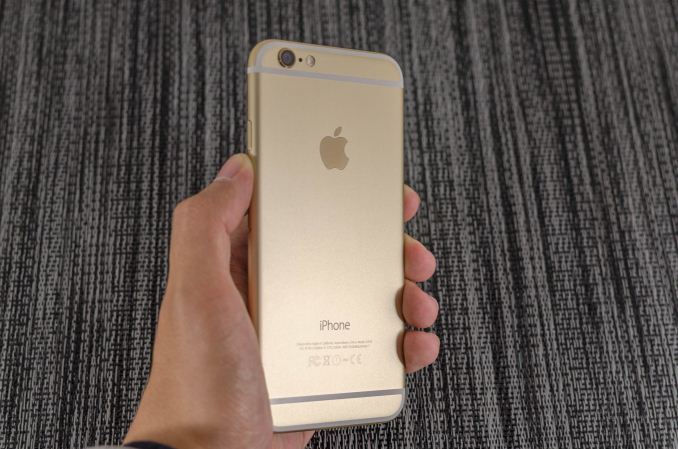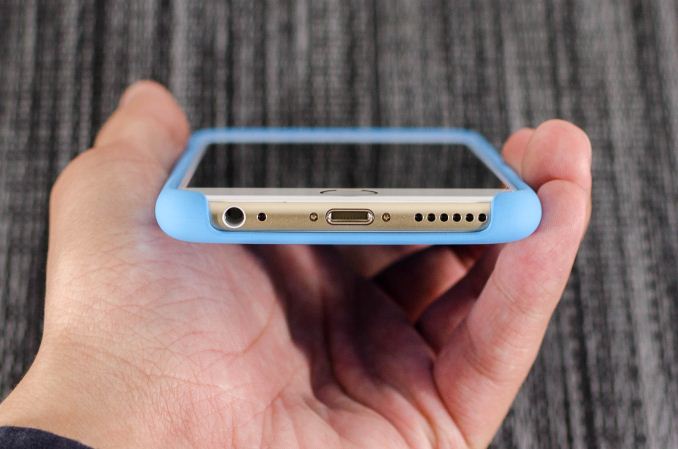The iPhone 6 Review
by Joshua Ho, Brandon Chester, Chris Heinonen & Ryan Smith on September 30, 2014 8:01 AM EST- Posted in
- Smartphones
- Apple
- Mobile
- iPhone 6
Final Words
Overall, the iPhone 6 is a significant step up from the iPhone 5s. One of the first areas where we see noteworthy changes is in the industrial design of the phone. Instead of the hard edges that we saw with the iPhone 5 design, the sides of the phone are now all curved in nature to give much better in-hand feel, and the result is surprisingly appealing as well due to how the glass curves down to meet the metal body. The iPhone 6 is also sitting right around the best balance of display size and one-handed usability, which helps with the in-hand feel aspect. I really have to make it a point to address size in the case of the iPhone 6. While this is definitely a matter of personal opinion and will vary from person to person, I find the size of the iPhone 6 to be refreshing after using phone after phone that pushed display size too far. While Reachability is definitely helpful, the size of the iPhone 6 is such that I really wouldn't miss such a feature on the iPhone 6 because it is an appropriate size. I never really had any issue handling a flagship from 2013 like the Nexus 5, Galaxy S4, G2, or One (M7), so this is a recent issue for me. Those that find those phones to be a good size will likely find the iPhone 6 to be similarly fit for their hands.
While I like the iPhone 6’s industrial design, increasing overall thickness to eliminate the camera hump could be an interesting variation as it would also bring a larger battery. Some users may also dislike the thick plastic lines, though I personally don’t notice this in day to day use.
The display itself is also a solid improvement, with incredible native contrast, high brightness, great viewing angles, and great calibration. I still feel like I’d want higher pixel density to make it the “perfect” display, but it’s clear that there are some very real limitations on resolution selection for iOS devices due to the point system used. Given that the resolution cannot be changed, the iPhone 6’s display is ultimately one of the best I’ve seen all year.
The SoC is also a significant upgrade, although not quite the jump that we saw from A6 to A7. For the most part, the architecture of the new CPU cores is relatively similar and we see a jump in GPU performance that puts the GX6450 on par with the Adreno 420. Apple continues to ship some of the best CPU and GPU choices on the market, and in our GFXBench rundown test it’s obvious that Apple has an extremely efficient system as skin temperatures remain in check while running at maximum performance for the duration of the GFXBench test. It’s clear that the NAND is also of high performance, although random I/O performance isn’t quite as amazing as sequential performance.
In battery life, once again Apple has managed to successfully maintain good battery life despite a relatively small battery capacity. The iPhone 6’s battery life is consistently near the top tier in this category. In the GFXBench rundown where the iPhone 6 falls short it makes up for it with incredible sustained performance.
Outside of the basic user experience, there are still even more improvements. The new camera seems to have better low light performance than before, along with significantly improved focus speed. The continuous auto focus enabled by phase detection autofocus is a killer feature for video when combined with the improved stabilization function. For a relatively small sensor size, Apple has managed to drive performance that rivals the relatively larger cameras of the competition. At the 1/3” sensor size, I’m not aware of a camera that is more balanced in its capabilities for daytime photography, low light photography, and anything in between.
In audio quality, Apple has delivered a solution on par with HTC’s audio solution, which places it among the best for this generation that we’ve tested. While there are some issues, there’s relatively little value to pushing audio quality any further unless high resolution audio becomes common.
Finally, the software experience continues to be great. Apple has taken advantage of the increased display size to increase information density out of the box, and generally improved the polish of iOS with iOS 8. We continue to see strong integration of TouchID into software, and with time I expect to see its value increase even more as Apple Pay and the use of TouchID for third party apps becomes widespread. There are only two significant issues that I noticed in my week with the iPhone 6, and one is because the application was originally intended for iOS 6. The only flaw that the iPhone 6 has is a lack of RAM, and this is only an issue if you also felt it was an issue on the iPhone 5s.
Overall, the iPhone 6 has been a surprise for me. While not all that much changed on the surface, this is the first phone that I’ve reviewed all year where I’ve found more to like the deeper I dug. The iPhone 6 is a great phone in its own right and needs no qualifications in that recommendation. While as a current Android user I’m still reluctant to use the iPhone 6 as my only phone, the iPhone 6 is good enough that I’m willing to consider doing so.













531 Comments
View All Comments
rUmX - Tuesday, September 30, 2014 - link
Wait for USB Type-C.mrochester - Wednesday, October 1, 2014 - link
Why are we waiting? We should have had it 2 years ago when Apple released the iPhone 5.grayson_carr - Tuesday, September 30, 2014 - link
Can't agree with you there. My wife has been through countless lightning cables. Apple branded cables either come apart at the seam between the connector and cable or just stop working after 6 months to a year with heavy use, even if there is no visible external damage. Just look at the reviews of Apple's lightning cable on their website and you'll see how terrible they are: http://store.apple.com/us/product/MD818ZM/A/lightn... (80% are 1 star out of 5). Apple covers one replacement, but after that you're on your own. Third party lightning cables, no matter how reputable the brand, always either stop working after a while or the iPhone will suddenly start saying the third party accessory is not compatible.I think the chip Apple requires in lightning cables is the culprit for most of these headaches. I think they die quickly, far before the lifetime of the cable itself, which is why cables will suddenly stop working for no apparent reason or start being labeled as not compatible.
Whatever the cause, I have NEVER had a micro USB die on me. Micro USB cables are also much cheaper than lightning cables. Finally, all of my other electronics use micro USB (Chromecast, Android phones, Kindles, cameras, etc.) which is awesome! I can have a single cable in my car that charges all of my gadgets (except my wife's stupid iPhone of course). For those three reasons, micro USB is far superior to lightning. Being able to insert the stupid cable either way doesn't come close to outweighing the benefits of micro USB I just listed.
mrochester - Tuesday, September 30, 2014 - link
And to respond to that, I've never had any Apple cables, whether it be the old dock connector or lighting cables and ports, break. Contrary to that, my sister's USB port in her Galaxy S3 broke, her Samsung charger ended up with bent pins and my partner's Samsung Galaxy S2 charger ended up fraying at the micro USB end.mrochester - Tuesday, September 30, 2014 - link
Of course, being able to insert the cable in any orientation and it being more reliable makes the benefits of the lighting connector far outweigh micro USB.grayson_carr - Tuesday, September 30, 2014 - link
Well, since reliability could go either way depending on your luck, we have...1) Being able to insert the cable in any orientation
vs.
1) Much lower price
2) A standard that is compatible with many more devices (Cameras, e-readers, Android phones and tablets, Windows phones and tablets, hard drives, portable speakers, etc., etc., etc.)
I would take the bottom two benefits any day over the top single benefit. Imagine if every company was as stubborn as Apple and designed their own cable. I would have to have 20 different types of cables lying around my house and it would be a HUGE pain trying to find the correct cable for the device. Instead, I can have one or two micro USB cables that can work with pretty much anything in my house, excluding iOS devices of course. That principle alone is enough to make me dislike Apple's lightning cable. Standards are a good thing. Proprietary sucks. Thank God other companies haven't followed Apple's footsteps in that regard yet. If they ever do, we're all screwed.
mrochester - Wednesday, October 1, 2014 - link
And I'd take the top one over the two things you listed. Having loads of micro-USB cables that are used by absolutely no devices in my house (my Canon camera is mini USB) isn't a whole lot of use. There's no need to have 20 different cables lying around your house, just 2. Your lightning cables for your iPad and iPhone, and a micro-USB cable for everything else that's stuck in 2012.GerryS - Wednesday, October 1, 2014 - link
I agree. The reversability is nice, but not much of a feature to me. Every other cable I use, except circular power connectors, requires a specific orientation. It never takes more than two tries to find the right one.techconc - Thursday, October 2, 2014 - link
@grayson_carr - Your argument falls apart in multiple places. For starters, you assume reversibility is the only advantage of the lightning cable. It's not. The lightning cable allows for 12W charging while USB is limited to just 9W. Further, you mention the ubiquity of the USB cable as if there is just one type of USB cable. I seem to have a variety of USB types of cables including micro, mini, Type A and Type B (not to mention other proprietary variants) around the house. Please explain to me how this "standard" is working any better for me or the public in general?grayson_carr - Tuesday, September 30, 2014 - link
By the way, if you're in the same boat as me, I have a tip... buy your lightning cables at RadioShack. You can buy insurance on them and it will then only cost $2 to get a replacement when they inevitably stop working.